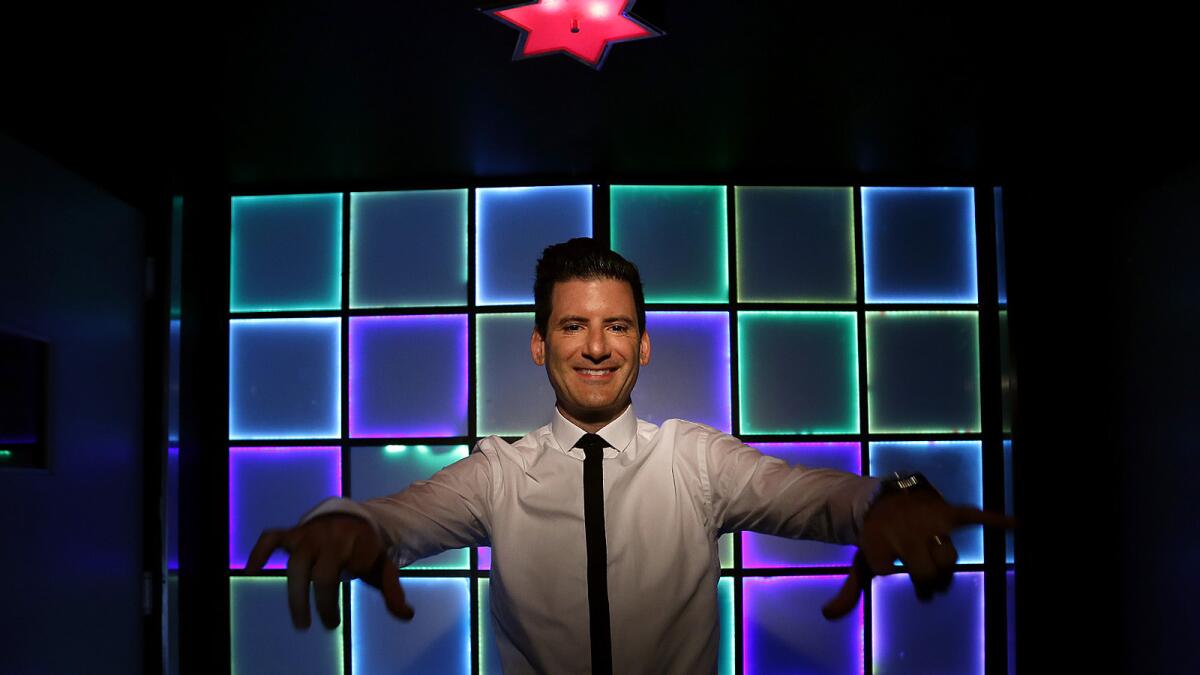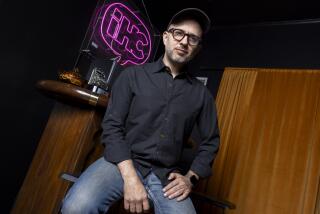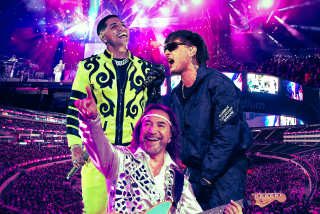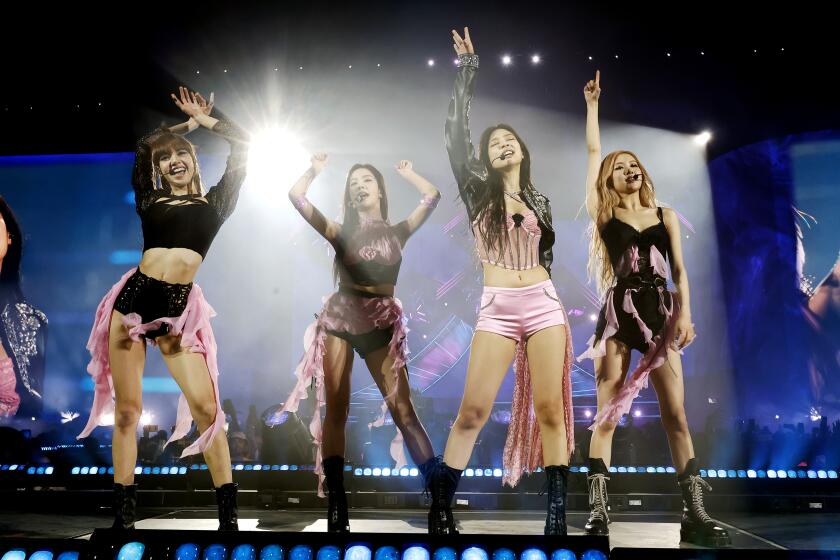Hard Summer is L.A.’s definitive dance festival, but it’s still searching for an iconic home

Gary Richards on staying current with his music
- Share via
Just weeks before the 10th anniversary of his marquee electronic music festival Hard Summer, Gary Richards made a decision that, over the last few years, had become familiar to his crew: pack up and head east.
With less than a month to go before the show, Richards abruptly moved Hard Summer from the Auto Club Speedway in Fontana to the Live Nation-operated Glen Helen Amphitheater, about 15 miles up the 15 Freeway. Richards said the change could make for a nicer fan experience, as there were plenty of difficulties — crowds, heat, traffic — with the Speedway.
But it’s the latest in a string of audibles for the popular festival. In 2015, L.A. County passed an ordinance regarding raves on county land that many saw as a specific deterrent to Hard Summer.
Civic pressure after several drug-related fan deaths, coupled with an unsure future with Live Nation, Hard’s parent firm, means that change is coming yet again for Hard Summer.
Richards has always defined the festival against a sense of uncertainty. “After [July] Fourth we kind of just re-evaluated everything that was going on and felt that that it [Glen Helen] was a better fit for this event for this year,” he said.
But the 46-year-old couldn’t hide his mixed feelings about moving Hard Summer to the fest’s fifth venue in five years.
“If I can find a home for me and Hard, it would definitely make things a million times better,” he said. “But that’s a credit to the fans that have stuck by me.”
Hard Summer has never been bigger or more influential in its decade-long run. This year’s lineup will see Snoop Dogg revisit his debut, “Doggystyle,” as well as some of the U.K.’s top grime stars, pop-and hip-hop crossover artists and reams of young, diverse DJ talent.
The fest now draws nearly 150,000 young electronic dance music (EDM) and hip-hop fans over its two days. What started as a Metro-accessible downtown L.A. show has drifted out to Whittier Narrows, Pomona, Fontana and now San Bernardino, but despite the moves, Hard Summer is still the definitive dance festival in L.A. It helped launch the careers of superstars such as Skrillex, Diplo and Deadmau5.

Early in July, in the otherwise empty penthouse of the Hotel Shangri-La in Santa Monica, Richards ordered a round of iced teas and reminisced about the time he and his family spent living by the beach in a nearby rental. Coincidentally, the hotel was close to the site where he threw his underground raves, which he called the Sermon, in the early ’90s.
After a year when his trademark festival came under fire after three fans who attended the event died, and he nixed the usual fall Day of the Dead edition outright, Richards was eager to look ahead — or even further back, at the broader context of his career.
When Hard Summer began in 2007 in downtown L.A., Richards already had started and ended a career throwing raves. He worked on the water park festival that would eventually become Electric Daisy Carnival, the massive fellow-Live-Nation festival run by rival promoter Pasquale Rotella. Richards also worked as a dance music A&R executive for Rick Rubin’s American Recordings, A&M and Interscope.
Richards recounts that first Hard show — held on New Year’s Eve — as a barely averted disaster. “I didn’t really know what I was doing, and most of the way through the show I was thinking ‘This was a bad idea,’” he said. “I was losing hundreds of thousands of dollars.”
The stage production team missed a cue when Justice was supposed to start its set at the stroke of midnight. “I literally had a mini heart attack,” Richards said. “I just walked away and threw my hands up. But my friend took me back out front, and somehow Justice was killing it and there were 5,000 people in leather jackets with their hands up. I saw this music was different — it wasn’t just a rave.”
There was indeed a movement stirring in L.A., where dance music could pair with hip-hop’s bounce and punk rock’s insouciance.
As EDM took off as a global phenomenon, Hard Summer rose with it. But the festival always stayed at arm’s length from the now-maligned genre, booking hip-hop, rock and R&B acts like the Weeknd, Ice Cube, Odd Future and Bloc Party.
“I know the music I play is totally niche and caters to a really specific underground audience, so it is incredibly humbling and exciting to hear that other people are into it,” said Madam X, the hotly tipped U.K. bass-music DJ, producer and label owner making her U.S. debut at the festival. “I’ve never been to the U.S., [but] I’ve known of Hard Summer and the lineup speaks volumes.”
That sensibility kept Hard Summer growing despite a volatile festival market, where shifting tastes, tricky financing and headliner homogeneity took a toll. In 2012, Live Nation inked a five-year partnership with Hard Events and helped expand it from the then-35,000-capacity L.A. State Historic Park to its 65,000-capacity current home. Richards also established a Hard-themed cruise series, Holy Ship, and satellite festivals in Australia and Denver.
But with that growth came skepticism about whether huge dance-music festivals like Hard Summer were an asset or a risk for local cities.
Security problems have dogged the fest from the start. Hard had to issue refunds in 2009 when police shut it down after fans at the Forum leapt from the balconies. In recent years, multiple fans have died of drug-related causes after attending Hard Summer, and venues ranging from the L.A. Memorial Coliseum (the former home of Electric Daisy Carnival) to the Pomona Fairplex have decided against hosting rave-style events.
In 2015, the L.A. County Board of Supervisors passed a new ordinance whereby an electronic music festival task force must give recommendations for future EDM events over 10,000 people — and none have occurred on county property since.
For Richards, it’s been a constant struggle to find — or persuade — venues that his brand-name festival made sense. That meant going farther east, away from L.A.’s urban core and into exurban venues where logistics can be more difficult. Hard Summer now lacks a single, visually iconic location like Coachella but has all the planning challenges of a major music festival.
Richards admitted that he’s revisiting his agreement with Live Nation and isn’t sure whether it will continue. When he signed the deal, ”I was looking for more expertise, but also funding. If you’re ever going to be in the concert business, Live Nation is one of the best places you could be,” he said.
But Hard’s ongoing issues (and rivalry with Live Nation’s Insomniac) may be straining that relationship.
A representative for Live Nation declined to comment.
“Right now, my main thing is focused on making this show great, and then we’ll see what happens after that. It’s kind of a big question mark,” Richards said.
And he still wrestles with how, exactly, the deaths of fans should change Hard’s security practices.
If festivals could test drugs on-site, he said, “they could save lives.” But ”when you’re a concert promoter, my job is supposed to be to get Snoop Dogg down there. How do you stop a Tic Tac from getting into a place with 100,000 people?” he said.
“I have teams of people at Live Nation to run [security], so I always look to them. I didn’t sign up for all this to understand how quickly it takes someone to get to the hospital.
“But the sad part of it all,” he continued, “is that everyone understands that it comes down to personal responsibility.”
Richards sunk in his chair. “Thank God I have the music, because when I get down in the dumps, it makes me want to continue,” he said.
So far, Hard’s fans have been willing to follow him.
This year’s festival has had a notable push for lineup diversity, bringing in U.K. grime acts such as Skepta and JME along with pop and R&B stars like Tinashe and Charli XCX, not to mention a slate of younger female producers including Madam X, Jubilee, Cray and Uniiqu3 (though a controversial promotional video, needling festival gender imbalances, divided fans).
“I’ve seen loads more females on lineups of late, which is really encouraging, but I would never want someone to book me because I fill in the ‘we-need-a-female-DJ’ criteria,” Madam X said. “Book a woman because she’s amazing at what she’s doing, and that’s something I think Hard Summer have got right.”
Cultural shifts, as much as location or ownership issues, may be the big question as Hard Summer moves into its second decade. Richards knows that a fest can’t just be escapist fun anymore.
“For me, with Hard, the message was that there was no message. The message was good music and partying, a place to get away from the crazy world,” he said. “But now we’re living in the craziest times in my life. I feel like I have this platform now, and I have to use it for something more than partying.”
For breaking music news, follow @augustbrown on Twitter.
More to Read
The biggest entertainment stories
Get our big stories about Hollywood, film, television, music, arts, culture and more right in your inbox as soon as they publish.
You may occasionally receive promotional content from the Los Angeles Times.











